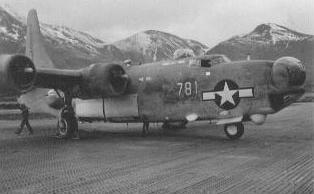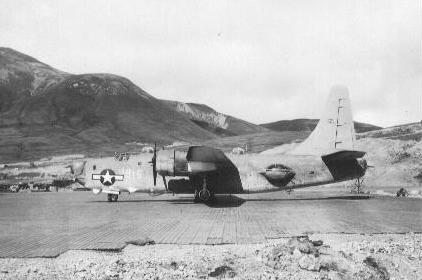
consolidated pb4y-2 “privateer’

Consolidated PB4Y-2 "Privateer"
The U.S. Navy made heavy use of their USAAF Service configured B-24D-derived
PB4Y-1 Liberators from August 1942 onwards in the Pacific and over the Atlantic.
In early 1943, the Navy placed a contract for an aircraft based on the original B-
24D Liberator design with enhancements for their use as a dedicated naval long-
range patrol bomber. Three B-24Ds were taken off the San Diego production line
and modified with a lengthened fuselage (by 7 feet), navalized interiors, greater
defensive armament, modified engine cowlings, and a distinctive vertical tail
similar to that fitted to the final Liberator transport variant.
The Navy ordered 739 aircraft in a single production run, with 286 delivered in
1944 and the remainder in 1945. Few had reached the front lines by VJ-Day,
although VP-24 did achieve operational status with the Bat anti-cruise missile in
the weeks prior to Japan's surrender. The Privateer went on to perform its best
work during the Cold War era as a radar and electronic countermeasures
platform. It was re-designated as the P4Y in 1951. After service with the U.S. Coast
Guard, the final units were retired in the early 1960s.
First Flight Date: 20 September 1943
Powerplants: Four Pratt & Whitney 1350-hp R-1830-94 Twin Wasp engines
Max Speed: 237 mph
Range: 2,800 miles
Weight: Empty 37,485 lbs; Max (Take-off) 65,000 lbs
Dimensions:
Wingspan: 110 ft 0 inches
Height: 30 ft 1 inch
Length: 74 ft 7 in
_____________________________________________________
Additional References: Jane's Historic Military Aircraft.
Photos by George Villasenor, an Aleutian WWII Combat Photographer working out
of Attu. Circa 1945.

This is a photo by George Villasenor of a
Navy PB4Y Privateer. This aircraft was
originally derived from the Army Air Force's
B-24D. Attu, AK. Circa 1945.

Another view of the Navy PB4Y
Privateer by George Villasenor.
Attu, AK. Circa 1945.
Current Update: 06/100/2022
Originally Published: 01/04/1999

consolidated pb4y-2 “privateer’

Consolidated PB4Y-2
"Privateer"
The U.S. Navy made heavy use of their USAAF
Service configured B-24D-derived PB4Y-1
Liberators from August 1942 onwards in the Pacific
and over the Atlantic. In early 1943, the Navy
placed a contract for an aircraft based on the
original B-24D Liberator design with
enhancements for their use as a dedicated naval
long-range patrol bomber. Three B-24Ds were
taken off the San Diego production line and
modified with a lengthened fuselage (by 7 feet),
navalized interiors, greater defensive armament,
modified engine cowlings, and a distinctive vertical
tail similar to that fitted to the final Liberator
transport variant.
The Navy ordered 739 aircraft in a single
production run, with 286 delivered in 1944 and the
remainder in 1945. Few had reached the front lines
by VJ-Day, although VP-24 did achieve operational
status with the Bat anti-cruise missile in the weeks
prior to Japan's surrender. The Privateer went on
to perform its best work during the Cold War era
as a radar and electronic countermeasures
platform. It was re-designated as the P4Y in 1951.
After service with the U.S. Coast Guard, the final
units were retired in the early 1960s.
First Flight Date: 20 September 1943
Powerplants: Four Pratt & Whitney 1350-hp R-
1830-94 Twin Wasp engines
Max Speed: 237 mph
Range: 2,800 miles
Weight: Empty 37,485 lbs; Max (Take-off) 65,000 lbs
Dimensions:
Wingspan: 110 ft 0 inches
Height: 30 ft 1 inch
Length: 74 ft 7 in
_____________________________________________________
Additional References: Jane's Historic Military Aircraft.
Photos by George Villasenor, an Aleutian WWII
Combat Photographer working out of Attu. Circa
1945.

This is a photo by George Villasenor  of
a Navy PB4Y Privateer. This aircraft
was originally derived from the Army
Air Force's B-24D. Attu, AK. Circa 1945.
of
a Navy PB4Y Privateer. This aircraft
was originally derived from the Army
Air Force's B-24D. Attu, AK. Circa 1945.
 of
a Navy PB4Y Privateer. This aircraft
was originally derived from the Army
Air Force's B-24D. Attu, AK. Circa 1945.
of
a Navy PB4Y Privateer. This aircraft
was originally derived from the Army
Air Force's B-24D. Attu, AK. Circa 1945.

Another view of the Navy PB4Y Privateer by George
Villasenor. Attu, AK. Circa 1945.
Current Update: 06/100/2022
Originally Published: 01/04/1999